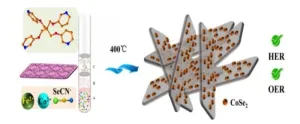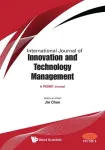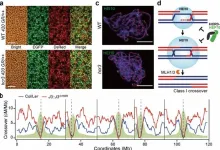(Press-News.org) By Gretchen Schrafft, Science Communications Specialist, Robert J. & Nancy D. Carney Institute for Brain Science
PROVIDENCE, R.I. [Brown University] — Imagine a busy restaurant: dishes clattering, music playing, people talking loudly over one another. It’s a wonder that anyone in that kind of environment can focus enough to have a conversation. A new study by researchers at Brown University’s Carney Institute for Brain Science provides some of the most detailed insights yet into the brain mechanisms that help people pay attention amid such distraction, as well as what’s happening when they can’t focus.
In an earlier psychology study, the researchers established that people can separately control how much they focus (by enhancing relevant information) and how much they filter (by tuning out distraction). The team’s new research, published in Nature Human Behaviour, unveils the process by which the brain coordinates these two critical functions.
Lead author and neuroscientist Harrison Ritz likened the process to how humans coordinate muscle activity to perform complex physical tasks.
“In the same way that we bring together more than 50 muscles to perform a physical task like using chopsticks, our study found that we can coordinate multiple different forms of attention in order to perform acts of mental dexterity,” said Ritz, who conducted the study while a Ph.D. student at Brown.
The findings provide insight into how people use their powers of attention as well as what makes attention fail, said co-author Amitai Shenhav, an associate professor in Brown’s Department of Cognitive, Linguistic and Psychological Sciences.
“These findings can help us to understand how we as humans are able to exhibit such tremendous cognitive flexibility — to pay attention to what we want, when we want to,” Shenhav said. “They can also help us better understand limitations on that flexibility, and how limitations might manifest in certain attention-related disorders such as ADHD.”
The focus-and-filter test
To conduct the study, Ritz administered a cognitive task to participants while measuring their brain activity in an fMRI machine. Participants saw a swirling mass of green and purple dots moving left and right, like a swarm of fireflies. The tasks, which varied in difficulty, involved distinguishing between the movement and colors of the dots. For example, participants in one exercise were instructed to select which color was in the majority for the rapidly moving dots when the ratio of purple to green was almost 50/50.
Ritz and Shenhav then analyzed participants’ brain activity in response to the tasks.
Ritz, who is now a postdoctoral fellow at the Princeton Neuroscience Institute, explained how the two brain regions work together during these types of tasks.
“You can think about the intraparietal sulcus as having two knobs on a radio dial: one that adjusts focusing and one that adjusts filtering,” Ritz said. “In our study, the anterior cingulate cortex tracks what’s going on with the dots. When the anterior cingulate cortex recognizes that, for instance, motion is making the task more difficult, it directs the intraparietal sulcus to adjust the filtering knob in order to reduce the sensitivity to motion.
“In the scenario where the purple and green dots are almost at 50/50, it might also direct the intraparietal sulcus to adjust the focusing knob in order to increase the sensitivity to color. Now the relevant brain regions are less sensitive to motion and more sensitive to the appropriate color, so the participant is better able to make the correct selection.”
Ritz’s description highlights the importance of mental coordination over mental capacity, revealing an often-expressed idea to be a misconception.
“When people talk about the limitations of the mind, they often put it in terms of, ‘humans just don’t have the mental capacity’ or ‘humans lack computing power,’” Ritz said. “These findings support a different perspective on why we're not focused all the time. It's not that our brains are too simple, but instead that our brains are really complicated, and it's the coordination that's hard.”
Ongoing research projects are building on these study findings. A partnership with physician-scientists at Brown University and Baylor College of Medicine is investigating focus-and-filter strategies in patients with treatment-resistant depression. Researchers in Shenhav’s lab are looking at the way motivation drives attention; one study co-led by Ritz and Brown Ph.D. student Xiamin Leng examines the impact of financial rewards and penalties on focus-and-filter strategies.
The study was funded by the National Institutes of Health (R01MH124849, S10OD02518), the National Science Foundation (2046111) and by a postdoctoral fellowship from the C.V. Starr Foundation.
END
Lack of focus doesn’t equal lack of intelligence — it’s proof of an intricate brain
A study by neuroscientists at Brown University’s Carney Institute for Brain Science illustrates how parts of the brain need to work together to focus on important information while filtering out distractions
2024-03-08
ELSE PRESS RELEASES FROM THIS DATE:
Many type 2 diabetes patients lack potentially life-saving knowledge about their disease
2024-03-08
The body's inability to produce enough insulin or use it effectively often results in type 2 diabetes (T2D), a chronic disease affecting hundreds of millions of people around the globe. Disease management is crucial to avoid negative long-term outcomes, such as limb amputation or heart disease. To counteract adverse consequences, it is crucial that patients have good knowledge about the day-to-day management of the disease.
A team of researchers in Portugal has now assessed how many patients – both insulin-treated and not insulin-treated – have this crucial knowledge about T2D. They published their findings in Frontiers in Public Health.
“Our main motivation ...
Small class sizes not better for pupils’ grades or resilience, says study
2024-03-08
Smaller class sizes in schools are failing to increase the resilience of children from low-income families, according to a study published in the peer-reviewed International Journal of Science Education.
Data on more than 2,700 disadvantaged secondary (high) school students shows that minimizing pupil numbers in classrooms does not lead to better grades. Reducing class sizes could even decrease the odds of children achieving the best results, say the study authors.
The quantity of teachers also does not increase the odds of pupils from the poorest backgrounds achieving academically, despite concerns over staff shortages in schools.
Instead, the researchers ...
Two-dimensional bimetallic selenium-containing metal-organic frameworks and their calcinated derivatives as electrocatalysts for overall water splitting
2024-03-08
Transition metal selenides have been considered to be a good choice for electrocatalytic water splitting. In addition, Metal-organic frameworks (MOFs) have been used to make catalysts with good electrocatalytic capabilities. Traditionally, the MOF-derived selenides are produced via the self-sacrificing MOF template methods. However, this strategy is high-energy consuming, and it is difficult to precisely control the structure and component homogeneity of the product during pyrolysis.
A research group of Wang-ting Lu, Fan Yu, and Yun Zheng ...
An increase in the number of extreme cold days in North China during 2003–2012
2024-03-08
How extreme weather and climate events change is an intriguing issue in the context of global warming. As IPCC AR6 points out, cold extremes have become less frequent and less severe since the 1950s, mainly driven by human-induced climate change. However, cold extremes could also exhibit robust interdecadal changes at regional scale.
A recent study by researchers from the Institute of Atmospheric Physics, Chinese Academy of Sciences, presents robust interdecadal changes in the number of extreme cold days in winter over North China during 1989–2021, and the findings have been published in Atmospheric and Oceanic Science Letters. ...
Open creativity: Increased creativity due to network relationships
2024-03-08
This paper's objective is to show that the network of frequent relationships that is established between agents in coworking environments, through weak ties, increases the generation of ideas. Thus, the present work argues that collaborative spaces can expand individuals' creativity, as they constitute a social hub for exchanging experiences and visions between individuals from different social and professional backgrounds [Blagoev et al. (2019)]. Through frequent relationships and weak ties, these social connections allow individuals to access different levels of insights and inspirations that make it possible to ...
Reptile roadkill reveals new threat to endangered lizard species
2024-03-08
The chance sighting of a dead snake beside a sandy track in remote Western Australia, and the investigation of its stomach contents, has led Curtin University researchers to record the first known instance of a spotted mulga snake consuming a pygmy spiny-tailed skink, raising concerns for a similar-looking, endangered lizard species.
Lead researcher Dr Holly Bradley from Curtin’s School of Molecular and Life Sciences said the discovery of the partially digested pygmy spiny-tailed skink within the snake had implications for the vulnerable western spiny-tailed skink species.
“Found about 300km east ...
Mutation solves a century-old mystery in meiosis
2024-03-08
Movies such as ‘X-Men,’ ‘Fantastic Four,’ and ‘The Guardians,’ which showcase vibrant mutant heroes, have captivated global audiences. Recently, a high-throughput genetic screening of meiotic crossover rate mutants in Arabidopsis thaliana garnered the interest of the academic community by unraveling a century-old mystery in the life sciences.
A research team, consisting of Professor Kyuha Choi, Dr. Jaeil Kim, and PhD candidate Heejin Kim from the Department ...
How a common food ingredient can take a wrong turn, leading to arthritis
2024-03-08
A University of Colorado Department of Medicine faculty member says she and her colleagues have identified the means in which bacteria in the digestive system can break down tryptophan in the diet into an inflammatory chemical that primes the immune system towards arthritis.
The research was co-authored by Kristine Kuhn, MD, PhD, Scoville Endowed Chair and head of the CU Division of Rheumatology. Several of her division colleagues collaborated on the paper, which was published in February in the Journal of Clinical Investigation.
Tryptophan is an essential amino acid found in many protein-rich foods, including meats, fish, dairy products, and certain seeds and nuts. It has many uses in the ...
Children with ‘lazy eye’ are at increased risk of serious disease in adulthood
2024-03-08
Adults who had amblyopia (‘lazy eye’) in childhood are more likely to experience hypertension, obesity, and metabolic syndrome in adulthood, as well as an increased risk of heart attack, finds a new study led by UCL researchers.
In publishing the study in eClinicalMedicine, the authors stress that while they have identified a correlation, their research does not show a causal relationship between amblyopia and ill health in adulthood.
The researchers analysed data from more than 126,000 participants aged 40 to 69 years old from the UK Biobank cohort, who had undergone ocular examination.
Participants ...
New treatment could transform the mental health of children with epilepsy
2024-03-08
A new psychological treatment for children with epilepsy, developed by a UCL-led team of scientists, has been shown to reduce mental health difficulties compared to standard care, a new study finds.
Mental health problems such as worries, low mood and behaviour problems are more common in children and young people with brain conditions such as epilepsy, than in the general population – with up to 60% of those with epilepsy having associated mental health disorders and many having more than one mental ...
LAST 30 PRESS RELEASES:
Journal of Nuclear Medicine Technology supplement highlights advances in theranostics and opportunities for growth
New paper rocks earthquake science with a clever computational trick
ASH 2025: Milder chemo works for rare, aggressive lymphoma
Olfaction written in bones: New insights into the evolution of the sense of smell in mammals
Engineering simulations rewrite the timeline of the evolution of hearing in mammals
New research links health impacts related to 'forever chemicals' to billions in economic losses
Unified EEG imaging improves mapping for epilepsy surgery
$80 million in donations propels UCI MIND toward world-class center focused on dementia
Illinois research uncovers harvest and nutrient strategies to boost bioenergy profits
How did Bronze Age plague spread? A sheep might solve the mystery
Mental health professionals urged to do their own evaluations of AI-based tools
Insufficient sleep associated with decreased life expectancy
Intellicule receives NIH grant to develop biomolecular modeling software
Mount Sinai study finds childhood leukemia aggressiveness depends on timing of genetic mutation
RSS Research Award for new lidar technology for cloud research
Novel AI technique able to distinguish between progressive brain tumours and radiation necrosis, York University study finds
Why are abstinent smokers more sensitive to pain?
Alexander Khalessi, MD, MBA, appointed Chief Innovation Officer
Optical chip pioneers physical-layer public-key encryption with partial coherence
How your brain understands language may be more like AI than we ever imagined
Missed signals: Virginia’s septic strategies overlook critical timing, study warns
Delayed toxicities after CAR T cell therapy for multiple myeloma are connected and potentially preventable
Scientists find cellular key to helping plants survive in saltwater
Medical cannabis program reduces opioid use
Immunotherapy works for sepsis thanks to smart patient selection
Cardiovascular events 1 year after RSV infection in adults
US medical prices and health insurance premiums, 1999-2024
Medical cannabis and opioid receipt among adults with chronic pain
Multichannel 3D-printed bioactive scaffold combined with siRNA delivery for spinal cord injury recovery
Triaptosis—an emerging paradigm in cancer therapeutics
[Press-News.org] Lack of focus doesn’t equal lack of intelligence — it’s proof of an intricate brainA study by neuroscientists at Brown University’s Carney Institute for Brain Science illustrates how parts of the brain need to work together to focus on important information while filtering out distractions




